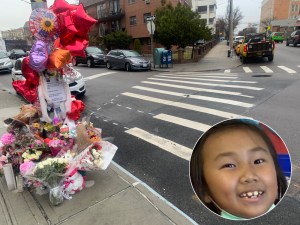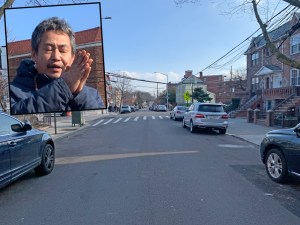After a Child’s Death, Can Newtown Road Be Reimagined?

Is this really the best the city can do?
It’s a question a growing chorus of community members are asking in the wake of the horrific death of Dolma Naadhun, 7, after DOT Commissioner Ydanis Rodriguez refused to commit to a stop light at a recent walkthrough with Dolma’s family, parents and elected officials. When repeatedly pressed, Rodriguez said the agency will study the corner of Newtown Road and 45th Street, where the child was killed by a driver who blew through a stop-sign controlled intersection that was not properly daylighted.
DOT has committed to adding a curb extension at the corner. But the agency didn’t commit to the full scope of an overhaul laid out by Council members immediately after the tragedy.
With several schools and the 46th Street subway station just steps away, Newtown Road — an angular, off-grid cut-through between Woodside and Astoria — is a favored shortcut for commuters and children alike. But using the British term, Newtown Road is also a true “rat run”; with its lack of stop lights, GPS apps direct drivers towards Newtown and away from busier streets.
Danger ensues.
DOT says that, statistically, the corridor has a “low crash history.” But it is a telling example of the systemic vulnerability baked into our street design: near-misses, peering around illegally parked cars, and hoping one stops — data that’s maybe less readily captured on paper, but part of the lived experience of everyday New Yorkers. (The number of complaints on DOT’s own map speak volumes.)
So, yes, there are newly installed “No Standing” signs at both corners where Dolma was killed, and a crosswalk has been repainted, but residents are stuck asking why the city isn’t thinking more boldly, as it did when it added life-saving interventions along 34th Avenue (now Paseo Park) in Jackson Heights or the “bike boulevard” on 39th Avenue in Sunnyside — all within walking distance of the spot where Dolma died.
What is needed?
The family has demanded a stop light — and more than 30,000 people have signed a petition seeking the signal organized by Dolma’s 11-year-old brother Takgye. But that’s the least the city can do, said Ivana Bologna, whose window looks out at the fated corner.
But without any enforcement or physical change to the street, these measures are worthless, she added. Since the No Standing signs have gone in — a baseline form of “daylighting,” or enhancing a corner’s visibility — she has seen cars regularly parked where they’re no longer allowed.
“They need to be ticketed,” she said. “Because, if they’re not, then what’s the point? That’s clearly not enough.”
Hsi-Pei Liao, a founding member of Families for Safe Streets, has been hesitant himself to embrace a stop light. A red signal didn’t save his 3-year-old daughter, Allison when she was killed at the corner of Main Street and Cherry Avenue in Flushing in 2013. But he understands channeling grief into something, even if it only slightly minimizes the probability of tragedy.
“I think everything we do is gonna help hopefully reduce the chance of another fatality in the future,” he said. “What’s the next step to help make it happen?”

Liao has floated the idea of piloting an Open Street along Newtown Road, dedicated to Dolma’s memory. This was the idea behind Apolline’s Garden, a new permanent plaza at the Fulton Street end of the much busier Gates Avenue, in the Clinton Hill section of Brooklyn, named for a baby who was killed there by a reckless driver in 2021.
“We should create a space where it’s safer for people and utilize the space for other things rather than just driving through,” he said. “I’ve shown where the Open Street is on, in Jackson Heights and it’s like really like, ‘Hey, by the way, this is your neighbor, and they did this for a mile long.’ Parents had heard about it, but they’re wanting to learn more.”
One concept that arose in interviews was this idea of what’s possible. Most New Yorkers understand two street safety devices: stop signs and stop lights. (Oh, and maybe speed bumps.) Let’s call it the Overton Window of street design; it’s the built environment to which we’ve grown accustomed — result of our collective failure to push that window towards more progressive change.
So, in that sense, it’s no surprise that many community members interviewed for this story have gravitated to the stop light, the most basic of requests. There are barely any pedestrian plazas in all of Astoria; a push for one along Newtown Avenue, the western segment of the thoroughfare, and 30th Avenue, was voted down by the community board in 2013.
Miser, a local advocate who doesn’t use their full name, likened Newtown to Broadway in Manhattan, a much more famous angular street that cuts through the urban fabric. That configuration has attracted the city’s attention through the Broadway Vision plan, which is adding “Shared Streets” and pedestrianized blocks. Can a similar idea be hatched in a calmer, more residential environment?
“It’s literally creating these perfect pedestrian places that make the city alive and make the city a destination everywhere it goes,” said Miser, who used to live near the corridor. “But for Newtown, it’d be a space for the people actually living here, because we also don’t have parks in the center of Astoria. It’s an attempt at creating a living space.”
Astoria is no Manhattan, but it’s equally starved of space. District 26, where the deadly crash occurred, ranks 41st out of 51 Council districts for parks access, according to Spatial Equity NYC. Meanwhile, the area falls into the “60- to 79-percent” range for zero vehicle households, per the latest DOT update. So it’s not neighborhood residents who are largely using this roadway to drive through the area.

Miser proposal for a Newtown Road that prioritizes pedestrians follows the idea of London’s low-traffic neighborhoods, which include limited local access, raised crosswalks, and built-out curbs. Any pedestrian improvements, Miser said, would inadvertently benefit cyclists, too; in this case, those headed to the new “protected” bike lane on Northern Boulevard, at Newtown Road’s terminus, and beyond. It would make it a more welcoming environment, for those on two feet or wheels.
Since the crash, Miser has shared materials on the Reddit page r/MicromobilityNYC and testified at a meeting with the 114th Precinct. Other neighbors joined. This tragedy, coupled with the recent death of a 62-year-old mother cycling on the other side of the neighborhood, has sparked outrage. But a greater shift is underway in how people are talking about this issue. Open Streets and Open Restaurants have helped, too.
“Back in those days, almost everybody was militarily opposed to any change to the streetscape,” Miser said, reflecting on the 2013 plaza push. “There’s been a lot of work to educate people, change the narrative, and now that these [street design changes] have been around 10, 15 years, people can see that actually, no, they do make the road safer and better, and none of the complaints and fear mongering were true.”
Getting the message
Until this last month, Sarah Chu, whose children went to school with Dolma, had never heard of the word “daylighting.” Within days after Dolma’s death, she had filled her Facebook with requests to call or write DOT, demanding for it. In school, her children and their classmates have been writing letters to the mayor, while parents, including Chu, have been reading up on street design.
“That’s not the only intersection that’s dangerous in Astoria,” she said. “It’s kind of shocking that — you know, knock on wood — that it doesn’t happen more.”
In addition to daylighting, she and others are advocating for physical obstructions — or vertical elements, as the city calls them — as part of any intervention to deter cars from still speeding up to the newly visible stop line. She admitted that she wasn’t a planner, and said the DOT had to quickly study what else could be done.
“And if the family wants a stop light, just give it to them,” she said. “On a personal level, as a parent, community member, and school member, I feel like it hit home more if you live in that neighborhood, if you knew her, if you played in that park, if you went to the same school. I mean, obviously like the whole Astoria community feels for the situation, but being one degree closer when you have those connections certainly makes you try to take more action.”
Bologna was infuriated when Dolma was killed — she arrived home an hour after, and said she still has the scene stuck in her head. She brought flowers to the site soon after, and comforted the child’s aunt, who was in disbelief. The crash — and its aftermath — has left her with lingering doubts about continuing to live on the corner she long cherished. And, also, frustration.
“Everybody knows how bad it is here,” she said. “And it’s like, there you go. This was the icing on the cake.”




